|
|
FIAT Grande Punto
|
 |
|
|
Debut: 2005
Maker: FIAT
Predecessor:
Punto II
|
|
|
|
| Published
on 27
Oct
2005 |
All rights reserved.
|
|
|
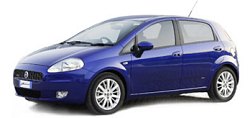 Looking
back to the history of Fiat Punto, we can see how quickly the
automotive world changes. The original Punto was launched in 1994. Its
pretty Giugiaro design, space-efficient cabin and fine engines (the
Super FIRE family) won it the title European Car of the Year. It became
the best selling mini car in Europe and even once topped the overall
European sales chart by beating the mighty Volkswagen Golf ! Looking
back to the history of Fiat Punto, we can see how quickly the
automotive world changes. The original Punto was launched in 1994. Its
pretty Giugiaro design, space-efficient cabin and fine engines (the
Super FIRE family) won it the title European Car of the Year. It became
the best selling mini car in Europe and even once topped the overall
European sales chart by beating the mighty Volkswagen Golf !
When Fiat updated the Punto to Mk 2 in 1999, it made three fatal
mistakes: 1) It forwent Giugiaro and designed the car by itself. The
result was an unattractive shape. That was made even uglier by the
"facelift" in 2003, again penned by Centro Stile Fiat. 2) The Mk2 was
derived from the Mk1 platform with all hardpoints unchanged. When its
new Japanese and European rivals introduced better packaging with
roomier cabin and flexible cargo space, the Punto suddenly became
outdated. 3) believe or not, I suspect the gone of the 4-stripe lucky
logo could be a reason for its fall. That logo was used in Panda Mk1,
Uno and Punto Mk1 - all are the most successful Fiats in modern time.
Since returning to the traditional circular logo, Fiat's fate has been
worsening…
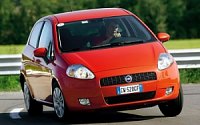 The
decline of Punto hit Fiat badly. It dragged the Italian giant into deep
financial trouble. Obviously, to save Fiat, the Mk3 Punto should be
successful. But Fiat did not have too much cash reserve to develop the
car. Also, it lost a lot of time due to frequent change of management.
Eventually, it decided to cooperate with GM - which was still its
partner then - and develop the Punto Mk3 and Opel Corsa based on the
same platform. This help reducing development time and cost. It also
saves purchasing cost because the two cars have 30 percent components
in common. This means Fiat can buy C-segment quality components at
B-segment price. The
decline of Punto hit Fiat badly. It dragged the Italian giant into deep
financial trouble. Obviously, to save Fiat, the Mk3 Punto should be
successful. But Fiat did not have too much cash reserve to develop the
car. Also, it lost a lot of time due to frequent change of management.
Eventually, it decided to cooperate with GM - which was still its
partner then - and develop the Punto Mk3 and Opel Corsa based on the
same platform. This help reducing development time and cost. It also
saves purchasing cost because the two cars have 30 percent components
in common. This means Fiat can buy C-segment quality components at
B-segment price.
The Mk3 Punto has added a first name "Grande", indicating its bigger
size. Compare with the Mk2, the Grande Punto is really grande, being
165 mm longer, 27 mm wider, 10 mm taller and runs a 50 mm longer
wheelbase. It is the only car in the segment that can compare with the
new Renault Clio in size. Interestingly, its wheelbase is 65 mm shorter
than the Clio but the overall length is 44 mm longer.
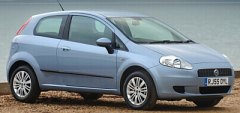 See the
pictures and you will understand why. The Grande Punto's front overhang
is unusually long for a mini car. The intention is to take it out of
the bulky shape of other mini cars. Together with a fast windscreen
angle and a pair of Maserati Coupe-like headlamps, the Grande Punto
looks really fresh and attractive. Who did the design? of course not
Centro Style Fiat ! officially speaking it is Giorgetto Giugiaro, but
in fact most of the car were penned by Bertone before Fiat handed the
design to Giugiaro, who reshaped the nose and transplanted the
headlamps from his own Maserati Coupe. At the rear, the elegant
tailgate is purely the work of Bertone. Interestingly, in one car you
can see the work of the two greatest Italian design houses. See the
pictures and you will understand why. The Grande Punto's front overhang
is unusually long for a mini car. The intention is to take it out of
the bulky shape of other mini cars. Together with a fast windscreen
angle and a pair of Maserati Coupe-like headlamps, the Grande Punto
looks really fresh and attractive. Who did the design? of course not
Centro Style Fiat ! officially speaking it is Giorgetto Giugiaro, but
in fact most of the car were penned by Bertone before Fiat handed the
design to Giugiaro, who reshaped the nose and transplanted the
headlamps from his own Maserati Coupe. At the rear, the elegant
tailgate is purely the work of Bertone. Interestingly, in one car you
can see the work of the two greatest Italian design houses.
If the attractive exterior design is the first sign of revival, then
the cabin is the second. The previous Punto was hampered by an
unattractive dashboard, a strange, Italian-style driving position and
relative lack of space and flexibility. The new Punto has corrected
these faults. Its steering wheel and driver's seat are multi-adjustable
so that finding a comfortable driving position is easy. Its enlarged
body accommodates four 6-footers easily. The 275 litres of luggage
space is also decent, and underneath it hides a useful storage tray for
tools and trivial. There are still no MPV-like flexible seating
arrangement - that should be fulfilled by Fiat Idea instead - but once
the 60/40 rear seat drops down the loading area is quite flat.
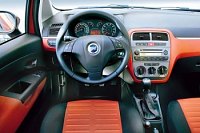 The
dashboard design avoids the funky / overstyled shape of many Japanese
and French rivals. Instead, it employs a more conventional but driver
pleasing arrangement. The Italian mini car also questions why all other
cars have their cabin in either grey or black. Instead, it uses a
body-colored decorative stripe running across the dashboard and
surrounding the center console to brighten the ambience and smarten the
design. You might remember the late Fiat Coupe also did that. The
dashboard design avoids the funky / overstyled shape of many Japanese
and French rivals. Instead, it employs a more conventional but driver
pleasing arrangement. The Italian mini car also questions why all other
cars have their cabin in either grey or black. Instead, it uses a
body-colored decorative stripe running across the dashboard and
surrounding the center console to brighten the ambience and smarten the
design. You might remember the late Fiat Coupe also did that.
There are some places lack quality touches, most notably the door
panels and grab handles, thus it won't threaten Renault Clio in terms
of quality feel. However, the fact that Fiat can build a larger and
higher quality Punto without asking a price hike like Renault Clio is
already an achievement.
On the road, the big Punto feels robust, refined and quiet. Its stiff
structure - with a class-leading torsional rigidity of 19,700 Nm/degree
for the 3-door and 16,500 Nm/degree for the 5-door - plays an important
role here, as is the improved suspensions. The Grande Punto uses the
same suspensions as the next generation Opel Corsa. All four corners
employ thicker rubber bushings to insulate NVH from the bodyshell. The
front MacPherson struts suspensions employ dual-link strut mounts to
reduce NVH. The lower wishbones are made of pressed steel sheets
instead of cast iron to reduce unsprung weight. At the rear, the
torsion beam is now made of different thickness depending on models,
thus saving the need for anti-roll bars for the more powerful models -
a technique learned from Opel Astra. This save weight of course.
Besides, the dampers are mounted vertically in order to absorb NVH
better. When driving the Grande Punto, most journalists were impressed
by its good bump absorption, even on broken surfaces, and the quietness
of its ride. In this way, the Grande Punto has the same sweet driving
manner as Panda.
 The Grande Punto also feels
light and agile on the road. Despite of its bigger size, it is not
overweight. A 1.4-litre petrol Grande Punto undercuts the similarly
sized Renault Clio 1.4 by 105 kilograms. This allows the Fiat continue
to rely on some fuel-efficient and cost-effective 8-valve engines. The Grande Punto also feels
light and agile on the road. Despite of its bigger size, it is not
overweight. A 1.4-litre petrol Grande Punto undercuts the similarly
sized Renault Clio 1.4 by 105 kilograms. This allows the Fiat continue
to rely on some fuel-efficient and cost-effective 8-valve engines.
Our focus is the 1.4-litre sohc 8-valve petrol. It is one of the two
petrol engines offered at launch (another is the entry-level 65hp
1.2-litre 8-valve). Compare with the various diesel engines, it puts
less weight at the nose of the Grande Punto and therefore has the most
faithful handling. The long-stroke engine produces only 77 horsepower,
but a relatively strong torque curve is useful in everyday driving.
Plus, the engine is smooth and quiet, well match with the smooth
5-speed gearbox and the refined ride quality.
Is it fun to drive? yes, for it is agile, smooth and easy to drive.
Sporty? never. It takes more than 12 seconds to accelerate from 0 to 60
mph, it rolls a lot in corners and its electric power steering
(succeeded from the previous Punto) delivers little feel.
However, Fiat could change that in the near future. It said a new
electric steering system will arrive next year. It will have a motor
mounted at the rack instead of steering column in order to improve
steering feel. Moreover, a 16-valve version of the 1.4 engine with 95
horsepower will be added next year. Then several really powerful
turbocharged engines will join the range: 1.4 turbo 120 hp, 1.4 turbo
160 hp and 1.6 turbo 180 hp. And rumor has that a 220 hp 1.6 turbo
Abarth model is also on the pipeline. It will use a two-stage
twin-turbo system like BMW 535d… The Grande Punto's chassis is
undoubtedly capable of handling more power, and the more powerful
engines will mate with sportier suspension setup, so the future is
promising....
To save Fiat, engineers rushed to put the new Punto into market in a
record-breaking 22 months. Luckily, they did the fundamentals right –
attractive styling, good packaging and capable chassis (also thanks to
Opel). They focused resources to the bread-and-butter models first,
most notably the 1.4 petrol and 1.3 Multijet, and successfully made
them lovely cars. The next step will be to plug in the remaining
puzzles, putting excitement back into the map. If they succeed, Punto
will be the class leader again while Fiat will be back to prosperity. |
Verdict:      |
| Published
on 27
Oct
2005 |
All rights reserved.
|
|
Diesel engines dominate
|
|
In the launch of Fiat Grande Punto, we can see the European
small car market has shifted towards diesel engines. This is especially
true to Fiat, which is the pioneer of common-rail injection technology.
The Grande Punto offers 4 diesel engines, in contrast to only 2 petrol
engines.
There is a pair of 1.3-litre Multijet 16V engines, rated at 75 hp (with
fixed turbo) and 90 hp (with VTG turbo) respectively. Fiat's Multijet
technology can inject up to 5 times during a combustion cycle,
including pre- and post-injections, to cut emission, noise and fuel
consumption. Both engines return over 60 mpg. They are also very
compact (Fiat claims they are the world's smallest diesel engines) and
relatively lightweight, at 130 kg including accessory.
The lower power engine has been used in the previous generation Punto
since 2003. By then it was praised for refinement, useful torque and
frugality. In the 110 kg heavier Grande Punto, it copes less well,
sometimes feeling breathless.
Some journalists regard the 90 hp 1.3 Multijet 16V as pick of the
bunch. Although its power deliver is not as smooth and linear as the
1.4 petrol, and somewhat laggy at low rev, its 147 lbft of mid-range
torque delivers remarkable real world performance, certainly faster
than the 0-60 mph figure (11.2 sec) suggest.
The other 2 engines are the long-serving 1.9 JTD with only 8 valves.
They are an outdated design, generating more noise and vibration than
the newer Multijet engines. They are also very heavy, burdening the
nose of the Grande Punto, hampering handling and ride quality
noticeably. In the absence of a fast petrol engine, Fiat wants the
120hp and 130hp 1.9 JTD to be the performance powerplant of Grande
Punto. Is it a wise decision? those tested it said the performance gain
over the 90 hp 1.3 Multijet 16V is slim in real world driving, not
enough to justify the price it paid in handling and the extra price
customer pay.
|
| Published
on 13
Jun 2006 |
All rights reserved.
|
|
1.4-liter 16V engine
|
With the introduction of the new
1.4-litre 16V petrol engine, the missing link in Grande Punto's engine
range is finally fulfilled. Based on the refined and eager but
underpowered 1.4-litre 8V, the new engine not only added a 16-valve
head but also a continuous variable valve timing and a port
deactivation system. It produces 95 horsepower (versus 77hp) and 92
lbft of torque (versus 85 lbft), improves top speed to 111 mph and 0-60
mph to 10.7 seconds. The engine is an all-round performer: sweet, brisk
and punchy enough. It could be the best mass production engine of the
1.4-litre class.
Surprisingly, at a combined cycle 46.3 mpg, the 16V drinks no more fuel
than its 8V sister. This is not without reasons – at light engine load,
the exhaust variable valve timing enables large overlapping between
intake and exhaust valve opening, thus introduces EGR (exhaust gas
recirculation) to reduce fuel consumption. Besides, the "port
deactivation" also plays an important role to frugality as well as low
speed torque. At low rev, one of the two intake ports for each cylinder
will be shut down, accelerating the intake air and create swirl, which
help mixing fuel and air.
|
Published
on 11
May 2007
|
All rights reserved.
|
|
Linea
|
|
 If
a line is an extension of a point, then Linea (Italian for line) must
be an extended and booted version of Punto (Italian for point). Fiat
designed the Linea mainly for developing countries, where 3-box compact
sedans are far more popular than in Europe. It will be produced in
Turkey, China, Brazil, India, Russia and eventually become the
company's second best selling car, just behind Punto. If
a line is an extension of a point, then Linea (Italian for line) must
be an extended and booted version of Punto (Italian for point). Fiat
designed the Linea mainly for developing countries, where 3-box compact
sedans are far more popular than in Europe. It will be produced in
Turkey, China, Brazil, India, Russia and eventually become the
company's second best selling car, just behind Punto.
Developing countries have different requirements from Western Europe.
First of all, the Linea must be cheap and economical to run. Secondly,
it should be able to carry a lot of luggage and goods. Thirdly, it
should look graceful because, while Punto is just a basic car in
Europe, Linea is a rather upmarket thing in developing countries. For
the same reason, it should offer greater space and comfort to please
those can afford it.
To satisfy these requirements, Fiat stretched the Punto's wheelbase by
93mm and installed a very long boot. The conversion from hatchback to
3-box is quite successful: the car remains handsome, the cabin space
greatly improved and luggage capacity
increased to 500 liters. A pair of new eyes distinguish it from Punto,
but their same genes are easily visible from the grille. Inside, a more
conservative dashboard is constructed base on the existing architecture
and parts. Hard plastics remain, but people in developing countries
care little about that. Instead, they will appreciate the abundance of
legroom at the rear seats which actually puts Linea into C-segment.
 To lower running cost, Linea is
offered with the smaller engines from Punto. At launch there will be
only the 77hp 1.4-liter 8V petrol and 90hp 1.3 Multijet turbo diesel.
With 4 people on board and the boot filled up, even the torquey diesel
engine could feel breathless. 0-60 mph takes nearly 13 painful seconds,
and the stressed engine sounds coarser than in Punto.
If you want more punch, you'll have to wait for Bravo's 120hp 1.4-liter
16V Turbo to join the range later on. However, Linea is clearly not
designed for great handling. Its softer suspension setup is tuned to
take on the poor roads commonly found in developing countries. As a
result, the ride is very supple and quiet, but the car rolls more in
corners than its hatchback sibling. The
dull steering doesn't promote driving pleasure either. To lower running cost, Linea is
offered with the smaller engines from Punto. At launch there will be
only the 77hp 1.4-liter 8V petrol and 90hp 1.3 Multijet turbo diesel.
With 4 people on board and the boot filled up, even the torquey diesel
engine could feel breathless. 0-60 mph takes nearly 13 painful seconds,
and the stressed engine sounds coarser than in Punto.
If you want more punch, you'll have to wait for Bravo's 120hp 1.4-liter
16V Turbo to join the range later on. However, Linea is clearly not
designed for great handling. Its softer suspension setup is tuned to
take on the poor roads commonly found in developing countries. As a
result, the ride is very supple and quiet, but the car rolls more in
corners than its hatchback sibling. The
dull steering doesn't promote driving pleasure either.
Unlike Fiat's previous "World Car", Palio, the Linea doesn't feel
second class next to Punto. It just has a different character. Being
stylish, comfortable and cheap, it should be highly attractive to
developing countries. I suddenly realize that Fiat's next profit steam
engine is not Bravo, but this low-profile "line".
|
Verdict:    |
Published
on 10
Oct 2007
|
All rights reserved.
|
|
Grande Punto Abarth
|
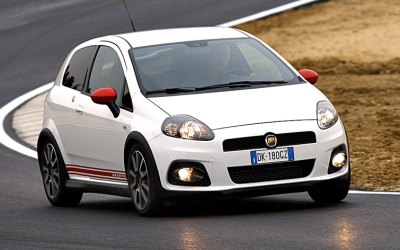
|
The
Abarth Punto is what a Mini Cooper S should have been...
|
2
years ago Grande Punto rushed out to the market in the attempt to save
Fiat from bankruptcy. To speed up its development, Fiat decided to
introduce the mass-selling bread-and-butter models first. They
successfully attracted customers back to Fiat and put it back to the
track of prosperity. Having done that, now Fiat finally get some time
to think about niche models. The first act is the new Fiat 500, which
should be another great success based on our recent findings. The next
step will be to relaunch Abarth as its performance brand.
Every big car maker has to have a performance brand. For example,
Renault has Renault Sport, Opel has OPC, Honda has Type R, Toyota has
TRD, Mazda has Mazdaspeed… But Fiat's Abarth is somewhat different: it
is a separate marque in its own right. Go back to history book, you
will find Abarth was founded by Carlo Abarth in 1949 as a racing car
maker. It designed racing cars based on mass production models, mostly
Fiats, and won hundreds of rallying and touring car races. Provided you
are old enough, you may remember its Fiat 600-based 850TC and 1000TC,
or after it was acquired by Fiat in 1971, the world
championship-winning Fiat 124 Abarth and 131 Abarth rally cars.
Unfortunately, entering 1980s Fiat withdrew from motor racing and
disbanded the Abarth team. Since then Abarth became no more than a
marketing symbol.
Now Fiat CEO Sergio Marchionne wants to revive Abarth as its
performance division. He gave it dedicated engineers and its own head
office in Turin. On the one hand it runs the company's racing program
with Grande Punto Super 2000 rally car, on the other hand it will
produce performance road cars, starting from the Grande Punto Abarth
(and soon to be joined with 500 Abarth). Furthermore, it will also make
money by selling performance kits for customers to upgrade their Fiats.
Now come back to Grande Punto Abarth. It will compete with Renault
Sport Clio, Opel Corsa OPC, Peugeot 207RC and Mini Cooper S in the
junior hot hatch segment. All these are strong rivals, but the Abarth
has an advantage: it looks more beautiful. Unquestionably, the Grande
Punto has always been a beautiful car. With some sporting flavours
injected, it looks even better. Up front, there are a pair of enlarged
intakes and black lip spoiler. The sides are decorated with red door
mirrors and Abarth red racing stripes graphics, which add to the
special feeling. Equally influential is a set of tastefully-designed
17-inch alloy wheels and black wheelarch extensions. At the back, there
are twin-exhaust and a black tailgate spoiler to complete the
modifications. One may wonder how these subtle changes deliver such a
great visual impact. The Italian knows very well that a tasteful design
is neither an overstatement like Opel Corsa OPC nor an understatement
like Peugeot 207RC. Instead, it is all about proportion, balance and
inspiration.
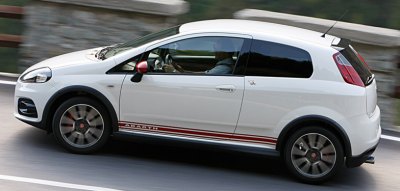 |
Tasteful styling puts it ahead of
other hot hatches, and then the driving experience and the exclusive
feel... this car has Abarth's scorpion badge instead of Fiat's logo.
|
The standard Grande Punto Abarth is powered by a tuned version of
Bravo's 1.4-liter T-Jet 16-valve turbo engine good for 155 horsepower
and 152 lb-ft of torque. This engine is smaller than Opel's and
BMW-PSA's 1.6-liter turbo, so it is not as powerful. However, like
other modern turbocharged engines, it is frugal, lag-free and provides
plenty of low down torque. Push the "Sport Boost" button on the
dashboard will quicken its throttle response and release another 18
lb-ft of torque at 3000 rpm, so overtaking is easy. We expect the car
to top 129 mph and accelerate from 0-60 mph in 7.7 seconds. It won't
match its pricier rivals, but the performance is satisfying and easily
accessible, thanks to the rounded engine and the close-ratio,
slick-shifting 6-speed gearbox.
For the chassis, the standard Abarth gets 10 mm lower ride height, 20%
stiffer suspension springs, stiffer shock absorbers, grippy 215/45R17
rubbers and Brembo disc brakes. The "Sport Boost" button also weighs up
the electrical power steering. On the road, the car displays excellent
body control, grip and braking, while the steering is quick, precise
and reasonably communicative. For around £13,500, it is
undoubtedly a tempting purchase.
However, what really lifts the Abarth above its rivals is the Esseesse
(Super Sport) version. This is a £3,500 upgrade kit installed at
Abarth dealers. It boosts the engine to 180 horsepower and 201 lb-ft of
torque by means of increased turbo boost pressure and higher flow
intake and exhaust. Its 0-60 time of 7.2 seconds still fails to match
Mini, Corsa and Clio (they take between 6.2-6.9 seconds), but what
matters is not absolute speed but how the driver feels. In the Abarth
Esseesse, you will feel more exciting than any other junior hot hatches
on the market. This comes from its race-car-like exhaust roar, its
sweet gearchange, its ability to sharpen throttle response and steering
by the "Sport Boost" button and the noticeable power kick once its
turbo get into full charge. Yes, Abarth trades some refinement for raw
excitement, which is a good thing when Corsa OPC and Mini Cooper S are
being criticized for too dull.
Apart from engine, the Esseesse upgrade kit also drops the ride height
by another 20 mm (which means an astonishing 30 mm lower than the
regular Grande Punto) and stiffens the suspensions further. Larger
18-inch OZ wheels, drilled disc brakes, better brake pads and lower
profile tires are employed. On the road, the car feels tight and sharp,
more hardcore driver-oriented than any other rivals. Its stiff ride
does not suit B-roads, but its tight body control and sharp handling is
confidence inspiring. The increased negative camber resulting from
dropping the ride height gives it excellent front end grip in corners
so that there is hardly any trace of understeer. The sharpened steering
lets the driver to guide it accurately through S-bends at amazing
speed. Besides, there is no torque steer at all. In addition to the
excellent brakes, engine and gearbox plus the tasteful styling, Grande
Punto Abarth Esseesse has a package that keen drivers cannot resist !
From this point of view, Fiat's sales forecast of 5,000 Abarths and
2,000 Esseesse kits per year seemed to be too conservative. |
Verdict:      |
| Published
on 29
Oct 2009 |
All rights reserved.
|
|
Punto Evo and Multiair engines
|
4
years on the market, FIAT Grande Punto has received a refresh as well
as a new name – Punto Evo. Gone is the word "Grande", which was
originally adopted to distinguish the Mk3 from the Mk2 that was still
in production then. Following the retirement of the old car, its name
is finally reverted to normal. Regarding "Evo", it implies the car is
an evolution of the outgoing car rather than just a simple facelift. In
fact, it covers extensive improvements in packaging, engines
and chassis.
Externally, you can easily distinguish the Evo from the outgoing car by
its new nose. The prominent front grille of the Grande Punto used to be
its highlight and trademark. Somehow, the Giugiaro design delivers less
visual impact after four years, especially when Mitsubishi copies this
feature to every Colt and Lancer. This time the in-house design team of
FIAT adopted a slimmer, more sophisticated nose with a black central
bumper between the upper and lower intake. A similar design is echoed
at the rear bumper. Together they increase the overall length by 35 mm.
Is the new design more beautiful than before ? I am not sure, but it
does look faster and sportier.
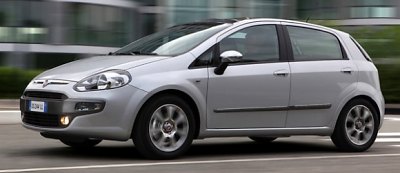
|
Multiair engines and other
improvements makes Punto competitive again...
|
Inside the cabin, the biggest change is the quality of materials – now
the dashboard is topped with softer plastics, the center console is
treated in high-gloss piano black, the door panels have more fabric
and less hard plastic… it feels far more expensive than before. Build
quality matches that of its key rivals bar Volkswagen Polo. Besides,
the evolution got upgraded equipments such as Bluetooth / MP3
connectivity and new infotainment system. As expected, cabin room is
unaltered. This mean spacious front seats and average space at the back.
In the chassis, the most obvious
improvement is running refinement. Thanks to extra sound deadening and
retuned suspensions, the ride is more refined and quieter. Wind and
road noise is significantly reduced in the cabin. However, the Punto is
still less engaging to drive than Ford Fiesta, or to lesser extent
Volkswagen Polo. Its handling still lacks the sharpness and playfulness
of Fiesta, and its electrical power steering is still too light and
numb to delight keen drivers.
Nevertheless, the Evolution brings it the strongest engine range of the
class. In the diesel side, the second generation 1.3 Multijet engine
can make up to 8 injections per combustion cycle. This not only lifts
its output to a useful 95 hp, but also improves its smoothness and
quietness considerably. Rivals should envy that FIAT has such a superb
entry-level engine on offer.
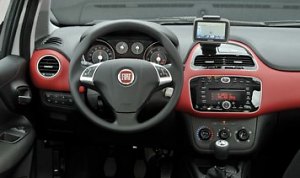
|
In the cabin, the biggest change is
the quality of materials...
|
In the petrol side, FIAT's new Multiair technology brings a new lease
of life into the long-serving 1368 cc Super Fire engine. As we have
studied in Technical
School, Multiair utilizes electrohydraulic parts
to liberate the possibility of valve operation. It can alter the
timing and lift of intake valves, open or close the intake valves
suddenly or even enable multiple openings within one cycle. This allows
FIAT's
powertrain engineers to tailor the valve strategy to optimize mixing
and combustion. As a result, it improves power by 10%, low-down torque
by 15% and reduces fuel consumption by 10%. In the Punto Evo, the
naturally
aspirated 1.4 Multiair engine produces a remarkable 105 horsepower, an
increase of 10 hp compared with the last 1.4 16V engine. Maximum torque
increases from 92 to 96 pound-foot, but the gain at low rpm is far more
apparent. Even as low as 1000 rpm you can feel its gusty delivery.
The last new engine is the light turbocharged version of the 1.4
Multiair. It produces 135 horsepower and as much as 152 lb-ft of
torque. 0-60 mph of 8 seconds is right in the league of warm hatches,
yet it achieves 50 mpg economy. Cool. Like most other engines in the
Punto Evo range, it has automatic start-stop function to help saving
fuel.
With these strong engines, Punto is once again a competitive choice in
the supermini segment. Although Ford Fiesta is still more fun to drive
and
Volkswagen Polo is more solidly built, the FIAT best seller has greatly
narrowed the gap, and should continue to lure a lot of customers with
its lower
asking prices. |
Verdict:     |
| Published
on 2
July
2012 |
All rights reserved.
|
|
Punto 2012 and TwinAir
|
|
Time did no favour
to aging cars. 7 years ago FIAT Grande Punto was a star in the
supermini class. Today, it is well overshadowed by countless of rivals.
By industrial practice, FIAT should have already renewed it by this
time, but in Italian fashion it is not going to replace the car until
it gets old, outdated, outclassed and cannot soldier on anymore.
Moreover, in the view of market recession in Europe, Sergio Marchionne
ordered a freeze of product development this year, therefore the next
generation Punto will not arrive until 2014 the latest. That means the
current car has to station for at least two more years! To prevent it
from sounding too outdated, a facelift is introduced this year. It also
has its name reverted to simply Punto.
Calling the Punto a facelift from Punto Evo is probably overstated.
Basically, it changed only the front bumper (from black to
body-colored) and discarded the chromed stripe above the nose. These
make it looks like the original Grande Punto again. Inside, we fail to
find any differences save some extra equipment. The so-called facelift
must be done with a tight budget. In the mechanical side, the Punto is
still offered with the same engines – 1.2-liter 8V 69hp, 1.4-liter 8V
77hp, 1.4-liter Multiair 105hp and 1.3 Multijet 75 or 95hp. The only
change is the drop of 1.4 Multiair turbo 135hp, as its demand has been
weak, and the addition of 875cc TwinAir turbo with 85hp.
The twin-cylinder engine has been using on 500 and Panda. Using it on
the heavier Punto puts some more strain on it, so you need to rev it
beyond 2300 rpm to get decent performance. Should you manage to do
that, you will find a lively character. Drop below 2000 rpm and it
becomes sleepy and unresponsive. Refinement is improved a little over
its smaller siblings thanks to the addition of balancer shaft and the
use of 6-speed manual gearbox (instead of 5-speeder). Still, the
TwinAir is not a choice for refinement. It vibrates heavily at both
idle and high rev. The loud, off-beat exhaust note is also intrusive to
ears if you are not in a mood to praise its special character.
Furthermore, the narrow power band means in the real world you are
difficult to keep it at the most efficient rpm, so its fuel consumption
falls short of its claims by a large margin. All these findings mean
the TwinAir is not as sweet as the 1.2-liter 69hp.
|
Verdict:    |
|
|
|
|
|
|
|
|
|
|
Grande
Punto 1.2
|
2005
|
| Front-engined,
FWD |
| Steel monocoque |
| Mainly steel |
| 4030 / 1687 / 1490 mm |
| 2510 mm |
Inline-4
|
| 1242 cc |
SOHC 8 valves
|
| - |
| - |
| 65 hp |
| 75 lbft |
| 5-speed manual |
F: strut
R: torsion-beam
|
| - |
| 175/60R15 |
1015 kg
|
| 96 mph (c) |
13.6 (est)
|
| - |
|
Grande
Punto 1.4 16V
|
2006
|
| Front-engined,
FWD |
| Steel monocoque |
| Mainly steel |
| 4030 / 1687 / 1490 mm |
| 2510 mm |
Inline-4
|
| 1368 cc |
DOHC 16 valves, VVT
|
| - |
Port deactivation
|
| 95 hp |
| 92 lbft |
| 5-speed manual |
F: strut
R: torsion-beam
|
| - |
| 185/55R15 |
1060 kg
|
| 111 mph (c) |
10.7 (est)
|
| - |
|
Grande
Punto 1.3 Multijet
|
2005
|
| Front-engined,
FWD |
| Steel monocoque |
| Mainly steel |
| 4030 / 1687 / 1490 mm |
| 2510 mm |
Inline-4, diesel
|
| 1248 cc |
DOHC 16 valves
|
VTG turbo
|
CDI
|
| 90 hp |
| 147 lbft |
| 6-speed manual |
F: strut
R: torsion-beam
|
| - |
| 195/55R16 |
1130 kg
|
| 109 mph (c) |
11.2 (est)
|
| - |
|
|
|
|
|
Performance
tested by: -
|
|
|
|
|
|
|
Grande
Punto Abarth
|
2007
|
| Front-engined,
FWD |
| Steel monocoque |
| Mainly steel |
| 4030 / 1687 / 1480 mm |
| 2510 mm |
Inline-4
|
| 1368 cc |
DOHC 16 valves
|
| Turbo |
-
|
| 155 hp |
152 lbft (170 lbft overboost)
|
| 6-speed manual |
F: strut
R: torsion-beam
|
| - |
| 215/45R17 |
1180 kg
|
| 129 mph (c) |
7.8*
|
| 23.0* |
|
Grande
Punto Abarth SS
|
2007
|
| Front-engined,
FWD |
| Steel monocoque |
| Mainly steel |
| 4030 / 1687 / 1460 mm |
| 2510 mm |
Inline-4
|
| 1368 cc |
DOHC 16 valves
|
| Turbo |
-
|
| 180 hp |
201 lbft
|
| 6-speed manual |
F: strut
R: torsion-beam
|
| - |
| 215/40R18 |
1180 kg
|
| 134 mph (c) |
7.2 (est)
|
| - |
|
Linea
1.3 Multijet
|
2007
|
| Front-engined,
FWD |
| Steel monocoque |
| Mainly steel |
| 4560 / 1730 / 1494 mm |
| 2603 mm |
Inline-4, diesel
|
| 1248 cc |
DOHC 16 valves
|
VTG turbo
|
CDI
|
| 90 hp |
| 147 lbft |
| 5-speed manual |
F: strut
R: torsion-beam
|
| - |
| 195/60R15 |
1185 kg
|
| 106 mph (c) |
12.8 (est)
|
| - |
|
|
|
|
|
| Performance
tested by: *Autocar |
|
|
|
|
|
|
Punto
Evo 1.4 Multiair
|
2009
|
| Front-engined,
FWD |
| Steel monocoque |
| Mainly steel |
| 4065 / 1687 / 1490 mm |
| 2510 mm |
Inline-4
|
| 1368 cc |
SOHC 16 valves, VVT+VVL
|
| - |
-
|
| 105 hp |
| 96 lbft |
| 6-speed manual |
F: strut
R: torsion-beam
|
| - |
| 185/55R15 |
1075 kg
|
| 115 mph (c) |
10.2 (c)
|
| - |
|
Punto
Evo 1.4 Multiair Turbo
|
2009
|
| Front-engined,
FWD |
| Steel monocoque |
| Mainly steel |
| 4065 / 1687 / 1490 mm |
| 2510 mm |
Inline-4
|
| 1368 cc |
SOHC 16 valves, VVT+VVL
|
| Turbo |
-
|
| 135 hp |
| 152 lbft |
| 5-speed manual |
F: strut
R: torsion-beam
|
| - |
| 185/55R15 |
1170 kg
|
| 124 mph (c) |
8.0 (c)
|
| - |
|
Punto
TwinAir
|
2012
|
| Front-engined,
FWD |
| Steel monocoque |
| Mainly steel |
| 4065 / 1687 / 1490 mm |
| 2510 mm |
Inline-2
|
| 875 cc |
SOHC 8 valves, VVT+VVL
|
| Turbo |
-
|
| 85 hp |
| 107 lbft |
| 6-speed manual |
F: strut
R: torsion-beam
|
| - |
| 185/65R15 |
1090 kg
|
| 107 mph (c) |
12.0 (est)
|
| - |
|
|
|
|
|
Performance
tested by: -
|
|
|
|
|
|
|
|
|
Copyright©
1997-2012
by Mark Wan @ AutoZine
|
|